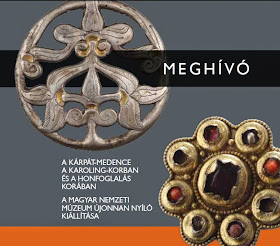 |
| Dress ornament from Zalavár (Photo: Hungarian National Museum) |
 |
| Ornamental discs from the Hungarian Conquest period (Photo: Hungarian National Museum) |
Taken together with the preceding part of the exhibition, this is the largest archaeological exhibition in Hungary, and one which is also quite informative and well-installed. Monitors with 3D-reconstructions and other interactive elements make the exhibition even more interesting for younger visitors as well. Ágnes Ritoók of the Hungarian National Museum acted as chief curator of the project, coordinating the work of two teams. This new exhibition is accompanied by two separate publications: one, written by Béla Miklós Szőke, is dedicated to Zalavár and the Carolingian period in Hungary, the other - the work of László Révész - is about the Conquest period. Both books were also published in English - so you can expect to read more about them on this blog soon.
The website of the National Museum has some technical problems, so I am linking here to the Facebook page of the Museum. The photos in this post come from there.


The Hungarian National Museum is a historical museum in Budapest. These things are the unique in the world that your images shared in this blog. These are one of the most famous tourist attractions are located there. My uncle was there before niagara falls 1000 islands tour with his business partner. This museum was founded in 1802 and the national museum of history, art and archaeology. It opens from 10:00am to 6:00pm every day. It offers to see many historical things about country. After reading your blog I want to go there in the month with my friends. We are big lovers of history.
ReplyDeleteGreat post, thanks so much for sharing.
ReplyDelete